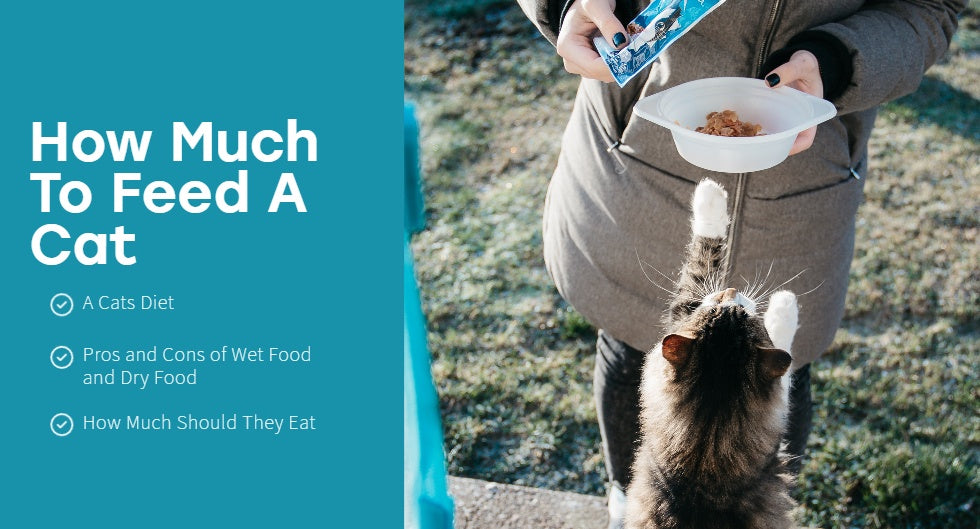A Cats Diet
House Cats are Obligate Carnivores, meaning they must require meat in their diet for survival. It is essential that cats are provided with a balanced diet rich in the Amino Acids, Arginine and Taurine which helps build blocks of protein in their bodies as well as stabilising neonatal health, heart function, their vision and reproduction. These nutrients only originate from animal-meat, therefore if meat wasn’t consistent in their diet it could lead to harsh deficiencies such as blindness and life threatening heart problems.
When purchasing cat food, be sure that the packaging is labelled ‘complete’, referring to the complete amount of nutrients it contains giving you reassurance that your cat will be provided with all the necessary nutrients and vitamins they need.
Wet Food or Dry Food
Wet Cat Food
| Pros | Cons |
|---|---|
|
|
Pros
- Contains the same Nutritional Values
- Smell and Meaty texture can be more appealing to dogs
- Contains water for extra hydration
- Tinned food can be stored for longer
- Can be helpful for cats with urinary tract disease, who are overweight and who suffer constipation
- Softer texture for cats with sore teeth
Cons
- Goodness doesn't last in the bowl throughout the day
- Can cause a strong lingering odour in the household
- Dearer for less
- Messy to deal with
- Can coat cats' mouth and lead to poor dental health
Dry Cat Food
| Pros | Cons |
|---|---|
|
|
Pros
- Contains the same Nutritional Values
- Longer shelf life
- Cheaper for more
- Can be a very efficient way of providing more calories to thinner cats who struggle to put on weight
- Clean to deal with
- Goodness does last in the bowl throughout the day
- Better for dental health
Cons
- No smell for cats’ appeal
- Doesn’t contain water
- Harder Texture
How Much Should They Eat
Obesity is an increasing issue for pets in the United Kingdom and overfeeding a cat can lead to a series of health problems such as arthritis and diabetes. Routinely weighing your cat can give you some insight for how much you should feed them in one sitting. Most commercial cat foods would have a feeding guideline on the packaging which can help you portion their food, however if your particular cat is below or overweight it’s important to tailor the guidelines (more or less) to reach their target weight. To do this, it’s ideal to weigh out your cat's portions to avoid overfeeding and if your cat loves their food and eats their entire daily portion in one sitting, it would be fitting to split their single portion into several smaller portions throughout the day.
Life-Stage Feeding
Kitten
It’s vital that kittens are fed food that is specifically labelled for ‘Kittens’, which is softer to chew for their developing teeth and easier to digest, this is also because Kitten food would be full of the correct nutrients that will contribute greatly to their growing bones and muscles. Also to avoid upset stomachs, it’s best to keep kittens on the same food that their breeder was feeding them, although if you want to add a new diet be sure to introduce this change gradually. Kittens also need to be fed a lot more small meals regularly throughout the day to stabilise their energy levels. However, once they are a few months old kittens can be weaned down to about two meals a day or they could prefer to just have access to their food so they can have little nibbles of it throughout the day.
Adult Cat
Once kittens hit their first birthday, they are then considered to be an adult cat until around 7 or 10 years of age. They will then be moved onto a new diet tailored to adult cats which contains the balance of nutrients that keeps them healthy and maintains their ideal weight whilst still supporting their energy levels. There are plenty of types of adult cat food that are specifically designed for each feline such as outdoor and indoor cats, urinary care or neutered cats etc. It’s best to speak to your vet to find which type of food is best for your cats health.
Senior Cat
Once your cat is around 7 to 10 years old, they would change onto a senior diet or an adult plus diet. At 10 to 14 years old they would then be on ageing or geriatric and this food can be a lot more easily digested with the right balance of nutrients as some parts of their diet would become more difficult for them to process as they get older such as fats, salt and proteins. The altered nutritional ingredients help maintain muscles and weight as well as support their organs to prevent obesity and organ disease.
If you are still not 100% sure what to feed your cat, always speak to your veterinarian for advice.

